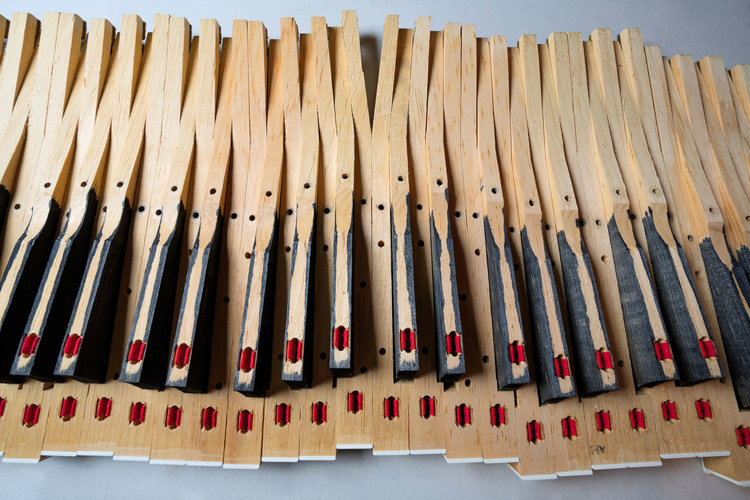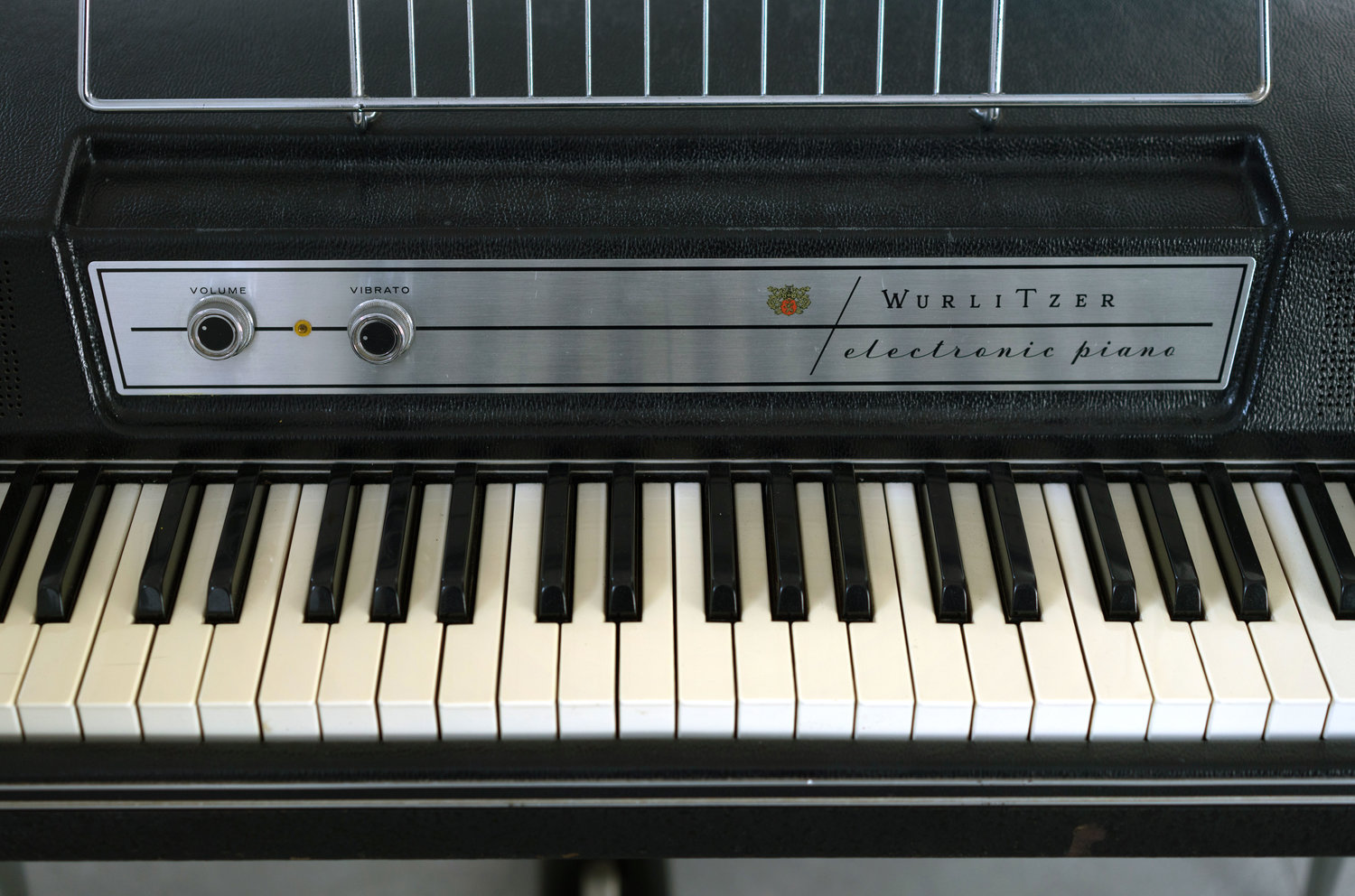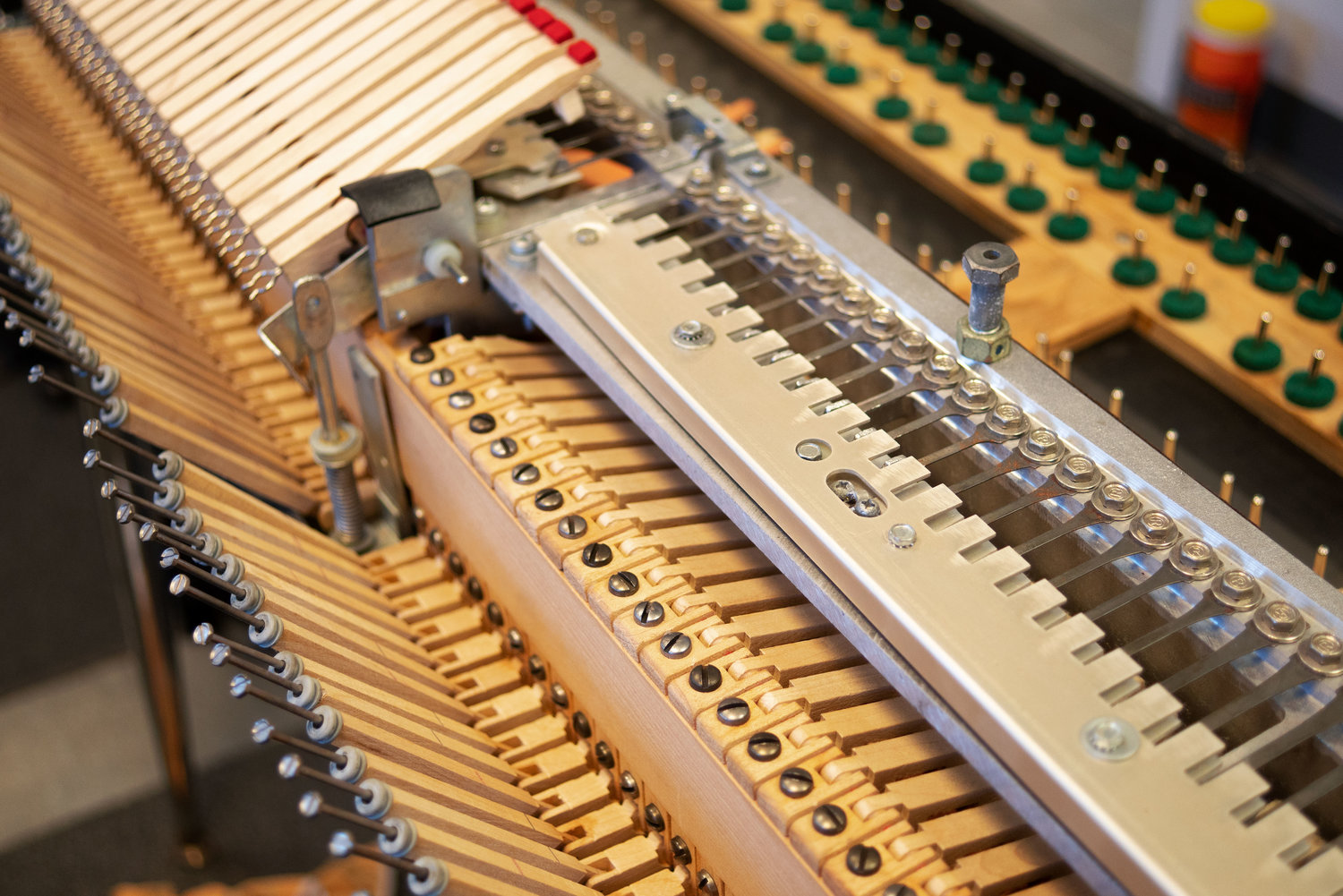On Wurlitzer shielding
This Wurlitzer 145 has a metal lid, which provides shielding. The black interior paint that you can see in this photo is electrostatic paint.
Because a Wurlitzer’s pickup is a source of noise, shielding is very important. If you’re missing part of your Wurlitzer’s shielding system, sourcing a replacement can be a quick way to improve your amp’s noise floor. However, sometimes its hard to tell what kind of shielding your Wurlitzer should have, because it varies among models.
The following list describes the various methods of shielding that different Wurlitzers employ. It is a work in progress and will be updated as we re-familiarize ourselves with examples of specific Wurlitzers. If you have a question about your Wurlitzer’s shielding, contact us and we’ll give you the best answer we can.
The Wurlitzer 112 has a wooden lid, which provides shielding by means of black conductive paint underneath.
Wondering if your Wurlitzer hums due to inadequate shielding or issues with its pickup? Unplug the input cable that connects the amp to the reed bar, then turn on your amp. If it is significantly quieter, your Wurlitzer will probably benefit from shielding. If there’s no change in the noise floor, the hum probably originates somewhere in the amplifier.
Note that this article discusses physical shields and not necessarily grounding schemes. If a ground is missing from the reed bar area, your Wurlitzer may become noisy. Check for missing grounds by examining the interior of your Wurlitzer carefully for evidence of absent screws or wires.
Wurlitzer 112. The 112 has very little shielding. On later 100-series models, the lid is metal and serves as a shield, but the lid of the 112 is made from wood. However, the inside of a 112’s lid has a layer of black conductive paint, which provides a measure of shielding as long as the braided wire wedged into the rim makes a good connection with it. There is also a long, narrow shield covering the pickups, which is mounted towards the front of the harp.
Despite the lack of shielding, 112 amplifiers can have very little noise if it is well cared for. If your Wurlitzer 112 hums like it needs an exorcism, it's not working properly. Check out our hum guide for details.
Wurlitzer 120/140/145. These Wurlitzer models have a metal lid which serves as a shield. In order to adequately shield, the lid must connect to chassis ground. This is accomplished by a thick braided cable that is stuffed underneath the lid, in the lip of the case. This cable works best when the lid is screwed down tightly. Ensure that all lid screws are present and that the lid isn’t dented in any way that might hinder its strong mechanical connection with the cable.
These Wurlitzers also employ the liberal use of electrostatic paint underneath the lid and around the case. The powdery black paint found inside the cabinet is meant to have shielding properties, so if it has been scraped off or painted over inside your Wurlitzer, you may have shielding issues. If nowhere else, this paint should be found where the braided cable meets the lid. If that spot has been painted over, you may be able to sand down to the original black paint with some patience and a high-grit sandpaper (800 or 1000).
There should be aluminum shielding tape underneath the amplifier. If it is missing or damaged, it should be replaced. Note that for the tape to shield the amp correctly, it must make good mechanical contact with the chassis screws.
The Wurlitzer 720 doesn’t have a metal lid for shielding. However, you can see the cabinet around the mechanical assembly has been painted with electrostatic paint.
Wurlitzer 700/720. These console Wurlitzers look like spinet pianos and have wooden lids. Like the 112, the interior of the lid has been painted with the powdery black electrostatic paint. As in a 120/140/145, the lid should be grounded with a braided cable, which should be firmly wedged between the black-painted portions of both the lid and the case.
The amplifier of a 700-series Wurlitzer is located at the bottom of the console. This is a positive feature where noise is concerned because the amplifier is situated so far from the pickup. Unfortunately, this design requires very long wiring harness and input cables. It is crucial that these cables are in good condition, because if they have deteriorated they can introduce noise. This is particularly true for the shielded cable carrying the input signal. Fortunately, rewiring is simple and often improves the noise floor of this type of Wurlitzer.
Wurlitzer 200/200a/203/206/206a/210. These models of Wurlitzer dispense with the metal lid in favor of a lightweight lid made from ABS plastic. Instead, they employ two methods of shielding: the hum shield and the reed bar shield. The reed bar shield is installed over the reed bar, underneath the damper arms. The hum shield fits over the whole action assembly and is screwed into place.
The reed bar shield is somewhat of a later development, so early Wurlitzers with a 200-style amplifier did not come with it. However, it will fit on any 200-series Wurlitzer, so if the reed bar shield isn’t present on your 200, 203, or 206, do not hesitate to source one.
The reed bar shield will actually fit on any Wurlitzer with 200-style reeds, a category that includes the 140a, 140b, and the 145. However, a reed bar shield installed on a 100-series Wurlitzer does not necessarily increase the amount of shielding, but often simply does the job that the metal lid otherwise would have.
The amplifier of 200a Wurlitzers is in two parts, with the preamp positioned in the center of the upper action assembly. The main circuit board is found below, on the amp rail. Isolating the preamp is a method of noise reduction, and it works well as long as the cables leading to and from are in good condition.
In earlier 200 model Wurlitzers, the layout of the components is extra sensitive. Sometimes, you can mitigate hum by moving certain wires or capacitors away from other components. If you do this, use a nonconductive stick like an orangewood stick or a chopstick to gently reposition components on the circuit board. Even if the amplifier is off, do not touch any leads with your bare hands or use any conductive materials as a probe. You may shock yourself or damage the amplifier. Always practice good electronics safety when working in an amplifier, including using just one hand to probe and taking care to stand on a nonconductive surface.
Further Reading
Browse all of our articles on restoring vintage gear. Or, click on an image below.







